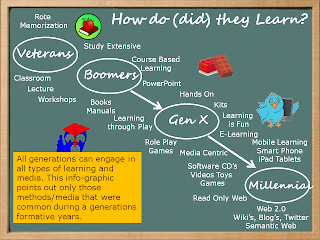This wordel to the right represents a new generation of thought in how the Net generation will conduct business in the future. To say the least, the lockstep industrial model created at the turn of the century, under mass production theorists like Fredrick Taylor, will soon find the key of change unlocking the doors for a new generation of learners.
So, back to the original question, how do schools become student centered? Who are our students? What are the demographics, needs, circumstances, life experiences, learning styles, and motivations of this generation of students?
From the picture on the right, you can tell that the next generation of learners are growing up with a new set of tools, different ways of communicating and new learning methods. In what ways might Net Generation learners differ from previous generations in how they think, learn, interact, and collaborate due to their experience with technology? In this slide, we can see the reusable tools that were provided for each generation of learners and how they learned.
Notice that in the top, left-hand corner of the diagram on the left, that veterans and boomers learned by extensive study, memorization, in classrooms, lectures, and workshops. As technology tools evolve, more prevalent devices begin to emerge such as electronic course based learning, and PowerPoint demonstrations. The widening Gen X generation gap was founded on the ideas of exploration, role playing games, and that learning is supposed to be fun, as hours of time is being consumed by multiple media formats. As we approach the millennial's, we are discovering a new type of learner that prefers mobile devices that encourage interactive formats of social engagement.
What are students' expectations for teaching, learning, service, and support? This question can only be answered when we ask the four essential questions about learning design. What you do not see is the central question of: ”When?”. When will we see the change to meet the needs of our learners?
Students in junior high, high school, and college are now finding means to communicate through the use of social networking tools, such as blogs, wikis and chat rooms. Although these types of collaborations may not be school related, they have become Americas youth pastime. While at the same time, a majority of schools have yet to be exposed to future capabilities of these new technology tools. The reason is that education has not recognized the full potential of Web 2.0 and new graduates in the field of education may now recognize the capabilities forming a gap of understanding and the potentials for harnessing social networking. Secondly, more advance schools will begin to encourage Web 2.0 online communities of knowledge gathering while the less advanced will take a backseat, wait and see attitude.
In this transition period, when three or four "generations" may be represented by students, faculty, and staff, is there a set of principles common across these generations that might help guide interaction, planning, and practices? In the center of the picture to the right is the one gifted individual who stands alone in a sea of complacency questioning the idea that one set of standards best portrays the individuals expression that becomes a new paradigm of thought.
In this transition period, when three or four "generations" may be represented by students, faculty, and staff, is there a common set of principles that might help guide interaction, planning, and practices? In the center of this slide, is the one gifted individual who stands alone in a sea of complacency, questioning the idea that one set of standards best portrays the individual’s expression that becomes a new paradigm of thought.
In part one, we have explored the importance of technology in a student centered school. We established important talking points around how is student learning different because of technology? We have identified the essential elements of technology planning from a process that is tied directly to the school’s central purpose of educating students and improved learning. We have identified the important roles that we will need to address through the characterization of student needs. With the first elements of technology planning identified, we will begin our conversations on the cycle of change.
Perhaps now is the time when education will merge on a new venture. A venture of making modified changes in the way education is delivered to students. These ventures of connected learning can no longer be done in isolation. It also will be up to the next generation of pedagogical designers to develop and embrace a richer conception of human capacity. A capacity that is intentionally designed and implemented through the use of rich, 2.0 literacy tools. Tools we currently have available for the expansion of connected learning opportunities.
Connected learning is also about a growth mindset. A mindset that seeks the challenges of change by thriving on stretching current ideas into new ones. It is a growth mindset that recognizes our future. We have a generation of students who need to be educated with the tools that provide them with expanded learning opportunities. The same tools they now use for social networking. It is in the mindset of knowledge curation through social networking that our teachers and students must embrace. Those are the same networks of social interaction that are now used in a constructive way. A way to curate, and create multiple digital resources that are specific to individual expressions of knowledge obtainment.




No comments:
Post a Comment